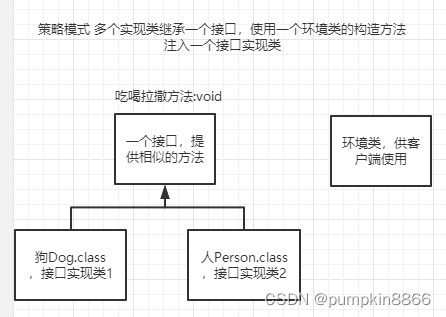
具体代码
public interface ActionInterface {
/**
* 吃喝拉撒 接口
*/
void eat();
void drink();
void put();
void sleep();
}
public class Dog implements ActionInterface {
@Override public void eat() {
System.out.println(“狗吃”);
}
@Override public void drink() {
System.out.println("狗喝");
}
@Override public void put() {
System.out.println("狗放");
}
@Override public void sleep() {
System.out.println("狗睡");
}
}
public class Person implements ActionInterface {
@Override public void eat() {
System.out.println(“人吃”);
}
@Override public void drink() {
System.out.println("人喝");
}
@Override public void put() {
System.out.println("人放");
}
@Override public void sleep() {
System.out.println("人睡");
}
}
public class Context {
ActionInterface actionInterface;
public Context(ActionInterface actionInterface) {
this.actionInterface = actionInterface;
}
public void action(){
actionInterface.eat();
}
public void drink(){
actionInterface.drink();
}
public void put(){
actionInterface.put();
}
public void sleep(){
actionInterface.sleep();
}
}
主方法
public class MainMethod {
public static void main(String[] args) {
Context context = new Context(new Dog());
context.drink();
context=new Context(new Person());
context.drink();
}
}
运行效果
狗喝
人喝
接口实现一定都会实现或者留空
策略模式优点:
扩展性好,可以在不修改对象结构的情况下,为新的算法进行添加新的类进行实现;
灵活性好,可以对算法进行自由切换;
策略模式缺点:
使用策略类变多,会增加系统的复杂度。;
客户端必须知道所有的策略类才能进行调用;
使用场景:
如果在一个系统里面有许多类,它们之间的区别仅在于它们的行为,那么使用策略模式可以动态地让一个对象在许多行为中选择一种行为;
一个系统需要动态地在几种算法中选择一种;
如果一个对象有很多的行为,如果不用恰当的模式,这些行为就只好使用多重的条件选择语句来实现;





















 366
366











 被折叠的 条评论
为什么被折叠?
被折叠的 条评论
为什么被折叠?








